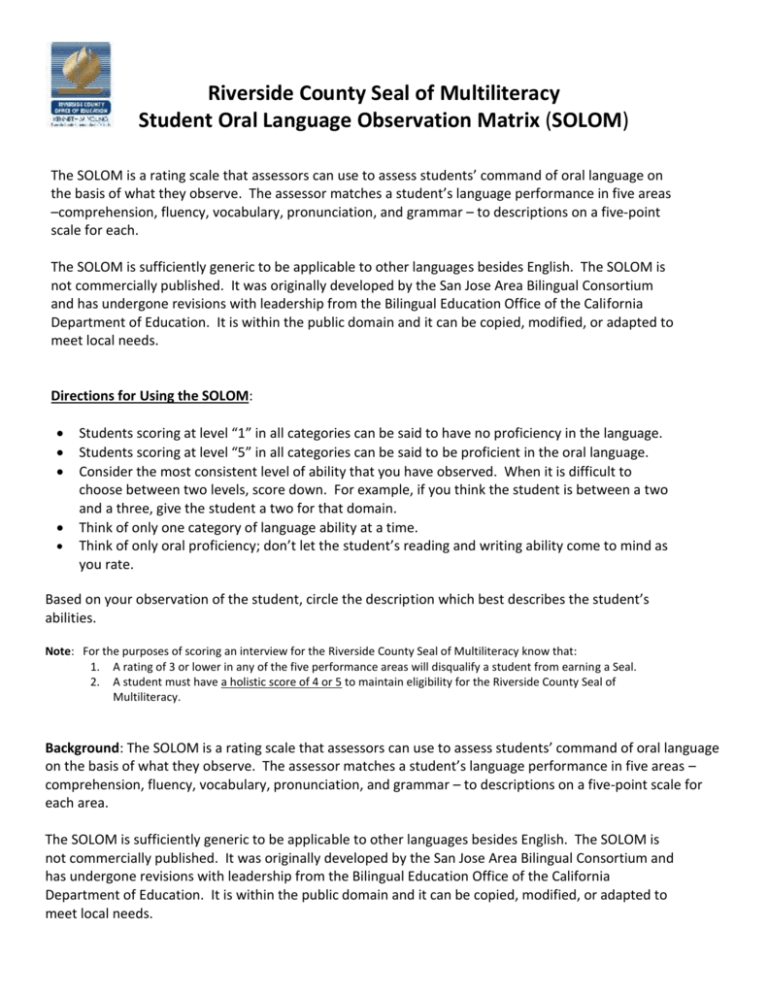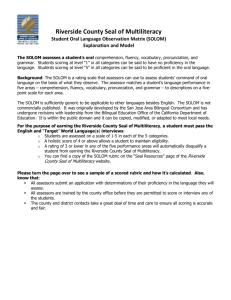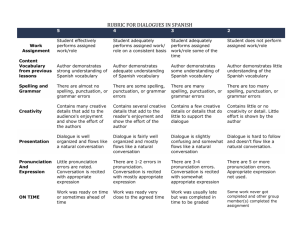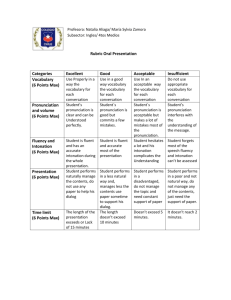SOLOM - Riverside County Office of Education
advertisement

Riverside County Seal of Multiliteracy Student Oral Language Observation Matrix (SOLOM) The SOLOM is a rating scale that assessors can use to assess students’ command of oral language on the basis of what they observe. The assessor matches a student’s language performance in five areas –comprehension, fluency, vocabulary, pronunciation, and grammar – to descriptions on a five-point scale for each. The SOLOM is sufficiently generic to be applicable to other languages besides English. The SOLOM is not commercially published. It was originally developed by the San Jose Area Bilingual Consortium and has undergone revisions with leadership from the Bilingual Education Office of the California Department of Education. It is within the public domain and it can be copied, modified, or adapted to meet local needs. Directions for Using the SOLOM: Students scoring at level “1” in all categories can be said to have no proficiency in the language. Students scoring at level “5” in all categories can be said to be proficient in the oral language. Consider the most consistent level of ability that you have observed. When it is difficult to choose between two levels, score down. For example, if you think the student is between a two and a three, give the student a two for that domain. Think of only one category of language ability at a time. Think of only oral proficiency; don’t let the student’s reading and writing ability come to mind as you rate. Based on your observation of the student, circle the description which best describes the student’s abilities. Note: For the purposes of scoring an interview for the Riverside County Seal of Multiliteracy know that: 1. A rating of 3 or lower in any of the five performance areas will disqualify a student from earning a Seal. 2. A student must have a holistic score of 4 or 5 to maintain eligibility for the Riverside County Seal of Multiliteracy. Background: The SOLOM is a rating scale that assessors can use to assess students’ command of oral language on the basis of what they observe. The assessor matches a student’s language performance in five areas – comprehension, fluency, vocabulary, pronunciation, and grammar – to descriptions on a five-point scale for each area. The SOLOM is sufficiently generic to be applicable to other languages besides English. The SOLOM is not commercially published. It was originally developed by the San Jose Area Bilingual Consortium and has undergone revisions with leadership from the Bilingual Education Office of the California Department of Education. It is within the public domain and it can be copied, modified, or adapted to meet local needs. Assessors’ Numbers: Language: Riverside County Seal of Multiliteracy Student Oral Language Observation Matrix (SOLOM) for Oral Interview District: Portfolio Number: For each column (lettered A-E), circle the 1, 2, 3, 4, or 5 box to score in each category. A. Comprehension B. Fluency C. Vocabulary D. Pronunciation 1 Cannot be said to understand even simple conversation. Speech is so halting and fragmentary as to make conversation virtually impossible. Vocabulary limitations so extreme as to make conversation virtually impossible. Pronunciation problems so severe as to make speech virtually impossible. Errors in grammar and word order so severe as to make speech virtually unintelligible. 2 Has great difficulty following what is said. Can comprehend only “social conversation” spoken slowly and with frequent repetitions. Usually hesitant; often forced into silence by language limitations. Misuse of words and very limited vocabulary make comprehension quite difficult. Very hard to understand because of pronunciation problems. Must frequently repeat in order to make himself/herself understood. Grammar and word order errors make comprehending difficult. Must often rephrase and/or restrict himself/herself to basic patterns. 3 Understands most of what is said at slower than normal speed with repetitions. Speech in everyday conversation and discussion is frequently disrupted by the student’s search for the correct manner of expression. Frequently uses the wrong words; conversation somewhat limited because of inadequate vocabulary. Pronunciation problems necessitate concentration on the part of the listener and occasionally lead to misunderstanding. Makes frequent errors of grammar and word order, which occasionally obscure meaning. 4 Understands nearly everything at normal speed, although occasional repetition may be necessary. Speech in conversation and discussions is generally fluent, with occasional lapses while the student searches for the correct manner of expression. Occasionally uses inappropriate terms and/or must rephrase ideas because of lexical inadequacies. Always intelligible, though one is conscious of a definite accent and occasional inappropriate patterns. Occasionally makes grammatical and/or wordorder errors which do not obscure meaning. 5 Understands everyday conversation and normal discussions without difficulty. Speech in everyday conversation and discussions is approximating that of a native speaker. Use of vocabulary and idioms approximates that of a native speaker. Pronunciation and intonation approximates that of a native speaker. Grammatical usage and word order approximates that of a native speaker. For Office Use Only: Comments: A holistic score of 4 or above allows a student to maintain eligibility. A rating of 3 or lower in any of the five performance areas will automatically disqualify a student from earning the Riverside County Seal of Multiliteracy. E. Grammar 4 Final Holistic Interview Score: Eligible for the Not eligible for the Riverside County Seal of Multiliteracy. Riverside County Seal of Multiliteracy. Assessors’ Numbers: Language: Riverside County Seal of Multiliteracy Student Oral Language Observation Matrix (SOLOM) for Oral Interview District: Portfolio Number: For each column (lettered A-E), circle the 1, 2, 3, 4, or 5 box to score in each category. A. Comprehension B. Fluency C. Vocabulary D. Pronunciation 1 Cannot be said to understand even simple conversation. Speech is so halting and fragmentary as to make conversation virtually impossible. Vocabulary limitations so extreme as to make conversation virtually impossible. Pronunciation problems so severe as to make speech virtually impossible. Errors in grammar and word order so severe as to make speech virtually unintelligible. 2 Has great difficulty following what is said. Can comprehend only “social conversation” spoken slowly and with frequent repetitions. Usually hesitant; often forced into silence by language limitations. Misuse of words and very limited vocabulary make comprehension quite difficult. Very hard to understand because of pronunciation problems. Must frequently repeat in order to make himself/herself understood. Grammar and word order errors make comprehending difficult. Must often rephrase and/or restrict himself/herself to basic patterns. 3 Understands most of what is said at slower than normal speed with repetitions. Speech in everyday conversation and discussion is frequently disrupted by the student’s search for the correct manner of expression. Frequently uses the wrong words; conversation somewhat limited because of inadequate vocabulary. Pronunciation problems necessitate concentration on the part of the listener and occasionally lead to misunderstanding. Makes frequent errors of grammar and word order, which occasionally obscure meaning. 4 Understands nearly everything at normal speed, although occasional repetition may be necessary. Speech in conversation and discussions is generally fluent, with occasional lapses while the student searches for the correct manner of expression. Occasionally uses inappropriate terms and/or must rephrase ideas because of lexical inadequacies. Always intelligible, though one is conscious of a definite accent and occasional inappropriate patterns. Occasionally makes grammatical and/or word-order errors which do not obscure meaning. 5 Understands everyday conversation and normal discussions without difficulty. Speech in everyday conversation and discussions is approximating that of a native speaker. Use of vocabulary and idioms approximates that of a native speaker. Pronunciation and intonation approximates that of a native speaker. Grammatical usage and word order approximates that of a native speaker. For Office Use Only: Comments: A holistic score of 4 or above allows a student to maintain eligibility. A rating of 3 or lower in any of the five performance areas will automatically disqualify a student from earning the Riverside County Seal of Multiliteracy. Form O (Revised 3.24.15 AW) E. Grammar Final Holistic Interview Score: 5 Eligible for the Not eligible for Riverside County Seal of Multiliteracy. the Riverside County Seal of Multiliteracy.







